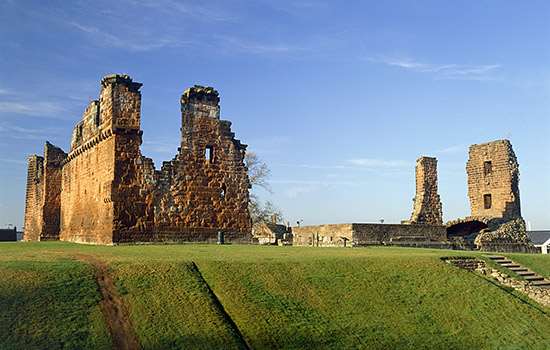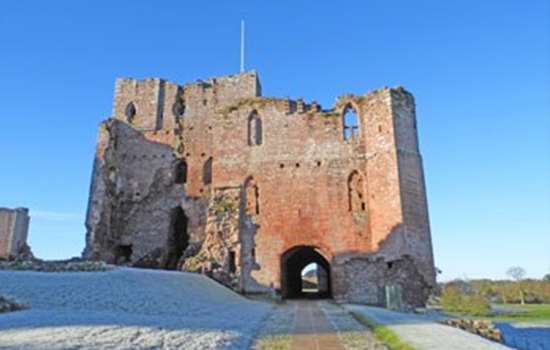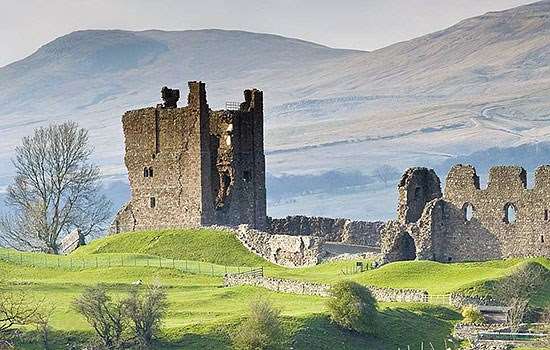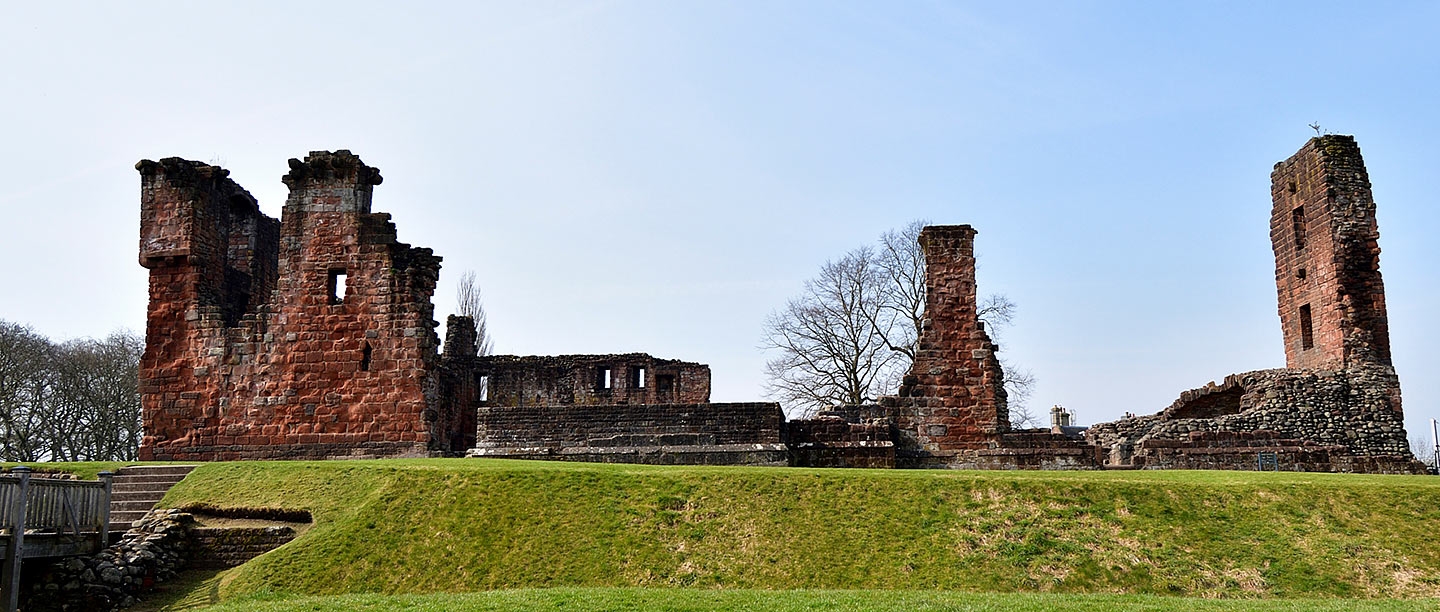Penrith and the Nevilles
Ralph Neville (about 1364–1425) was granted the manor of Penrith in 1396 and probably began building the castle soon afterwards. It is first mentioned in documents in 1412.
Though for much of the 19th and 20th centuries it was thought that Penrith Castle was built by William Strickland, later Bishop of Carlisle, there is no direct evidence for this. The royal licences granted to him in 1379 and 1399 to build a fortified tower may have referred instead to Hutton Hall, a 14th-century residential tower near St Andrew’s Church in Penrith town.
Ralph Neville was made Earl of Westmorland in 1397. As Sheriff of Cumberland, he was responsible for the defence of this area against the Scots in times of war, but most of his work involved acting on behalf of the Crown in the county. He and his successors were rarely resident in the border area: their power largely lay in holding offices in the Marches (the border areas) and the income these brought with them.
Contrary to what might be expected, the castle was not built at the highest point of the hill, which lies 170 metres away. Instead it sits on a low rise overlooking the medieval town, which pre-dated the castle.
Its architecture was not primarily concerned with defence. Though it offered the usual robust security measures of castles, monasteries and large urban residences of the day – gatehouses, secure doors, narrow windows on outward-facing walls – it was mainly a place of administration and diplomacy. Some of its early buildings in Ralph Neville’s time were probably of timber, built against the enclosing stone curtain wall.
The castle demonstrated Ralph Neville’s powerful position and his dominance over this area of Cumbria (medieval Cumberland and Westmorland). The Neville family’s rivals, the Cliffords, held the nearby ancient fortress of Brougham Castle, and were historically leaders in regional elite society. The Cliffords relied on the market in Penrith to supply Brougham, so the creation of a rival power base nearby inhibited their traditional domination of the town. In typical fashion, the two families were initially at odds in the Wars of the Roses (1455–87), in part because of this local rivalry.
In the early 15th century either Ralph’s widow, Joan Beaufort (c.1377–1440), or Ralph and Joan’s eldest son, Richard, 5th Earl of Salisbury (1400–60), made alterations to Penrith Castle. These probably included building the Red Tower on the north side of the castle, which overlies the corner buttress of the castle’s initial construction, and modifying the two entrances.
Richard, Duke of Gloucester
The 5th Earl’s son, Richard Neville (‘the Kingmaker’), 16th Earl of Warwick and 6th Earl of Salisbury, held the castle until he was killed at the Battle of Barnet in 1471. Edward IV then granted it to his younger brother, Richard, Duke of Gloucester (1452–85), who sometime between 1472 and 1474 married Warwick’s daughter, Anne Neville. Gloucester later became King Richard III (reigned 1483–5).
As Duke of Gloucester, Richard lived at the castle for several periods, and at different times held the positions of Sheriff of Cumberland and Warden of the West March. His role was to secure the two north-western counties against the Scots, maintain the peace treaty that his brother Edward IV agreed with James III of Scotland, and stick to agreed procedures for settling cross-border disputes.
Richard probably made alterations at the castle, adding significant new buildings and creating private accommodation for his officials. Large windows, probably to light a chapel mentioned in 16th-century documents, were inserted on top of the castle’s south-east range, at its east end. A new gatehouse and a massive tower were also constructed at this time on the opposite side of the castle, in the north-west range. The new gatehouse probably became the castle’s primary entrance, which was originally near the north-east projecting tower, overlooking the town.
A ‘castle garth’ mentioned in a 19th-century source hints that the castle may have had an additional, outer earth platform, surrounded by a ditch. Within it there may have been additional service and storage buildings and lesser accommodation. Richard’s gatehouse may have opened into this area, but the evidence is ambiguous.
Move the slider to compare a reconstruction of Penrith Castle in the time of Richard, Duke of Gloucester, with the same view today. Reconstruction © English Heritage Trust (illustration by Peter Urmston; funded by grant from Castle Studies Trust); photo © Historic England
Sixteenth-century changes
After Richard became king, the castle remained Crown property, but it was not used again as a permanent residence. Late 16th-century accounts and surveys record details about the castle which all testify to its general decline. However, recent research has found that five months of building works were recorded in 1577, suggesting there was a final phase of construction and occupation at the site.
After the 16th century the robbery of valuable dressed stone, timber, lead and iron from the castle continued. A passing mention in 1601 suggests all the new lead (probably fitted in 1577) had been removed. In 1648, during the English Civil War, the Parliamentarian Major-General John Lambert made the castle his base for a month, very likely occupying a decaying but not utterly ruined site. By 1695, however, it was described as in ruins. In 1696 William III gave the castle to his courtier William Bentinck, and in 1787 Bentinck’s descendants passed it on to the Devonshire family.
Railways, antiquarians and archaeologists
Passing references in the 18th century suggest the castle was appreciated for its romantic state of decay. In 1825 one source lamented that the site was set about with pigsties and animals, suggesting it was being used as a farm in what was then still a rural area on the edge of Penrith town.
An elephant’s tooth, found by archaeologists in the 1920s at the bottom of the moat, was radiocarbon-dated in 2015 to sometime between 1670 and 1880. It probably belonged to a circus animal. It is now in the Penrith and Eden Museum.
By 1845 the castle had changed dramatically with the completion of the access road to Penrith Railway Station, itself completed in 1846. The Lancashire and Carlisle Railway had bought the castle in order to build the station within the ‘castle garth’. This, together with the access road, meant the loss of probably half the castle’s medieval footprint.
In the second half of the 19th century the castle was occupied by a florist, who may have lived and worked in one of several structures built into the castle in that time. Several early photos give glimpses of these buildings, and at least one, a stable, is mentioned in 1907 as occupying the length of the south-east range. Antiquarian interest in the castle was growing at this time, too, with the Cumberland and Westmorland Antiquarian and Archaeological Society making funds available for excavations of the site.
In the early 20th century the London and North Western Railway (successors to the Lancashire and Carlisle) sold the castle to Penrith Council for £1,800. In 1913 it was transferred to HM Commissioners of Works. Planned excavations in 1914 were paused following the outbreak of the First World War. In 1919 Leeming, the foreman of works, was still mobilised in France. However, works were nearing completion in 1922, with more than £3,792 spent over the preceding decade. The castle has been in the care of English Heritage and its predecessors since then.
Further reading
The National Archive, Account of works at Penrith, E 101/479/13A
P Booth, ‘Richard Duke of Gloucester and the West March towards Scotland, 1470–1483’, Northern History, 36:2 (2000), 233–46
JF Curwen, ‘Penrith Castle’, Transactions of the Cumberland and Westmorland Antiquarian and Archaeological Society, 2 (1918), 174–88
JF Curwen, ‘The castles and fortified towers of Cumberland, Westmorland, and Lancashire North-of-the-Sands’, Cumberland and Westmorland Antiquarian and Archaeological Society, Extra Series 13 (Kendal, 1913), 219–23
F Haswell, ‘The castle of Penrith’, TC&WAAS, 7 (1907), 280–91
F Hudleston, ‘Penrith Castle’, TC&WAAS, 30 (1930), 12–26
DR Perriam, ‘William Strickland’s Tower in Penrith: Penrith Castle or Hutton Hall?’, English Heritage Historical Review, 3:1 (2008), 37–46
Find out more
-

Visit Penrith Castle
Penrith Castle was begun at the end of the 14th century by Ralph Neville, who played a key role in defending this area against the Scots.
-

Visit Brougham Castle
Imposing riverside castle ruins
-

Medieval Castles
Discover the stories held within the walls of England’s greatest fortifications and learn about the rise and fall of the medieval castle.
-

MORE HISTORIES
Delve into our history pages to discover more about our sites, how they have changed over time, and who made them what they are today.
